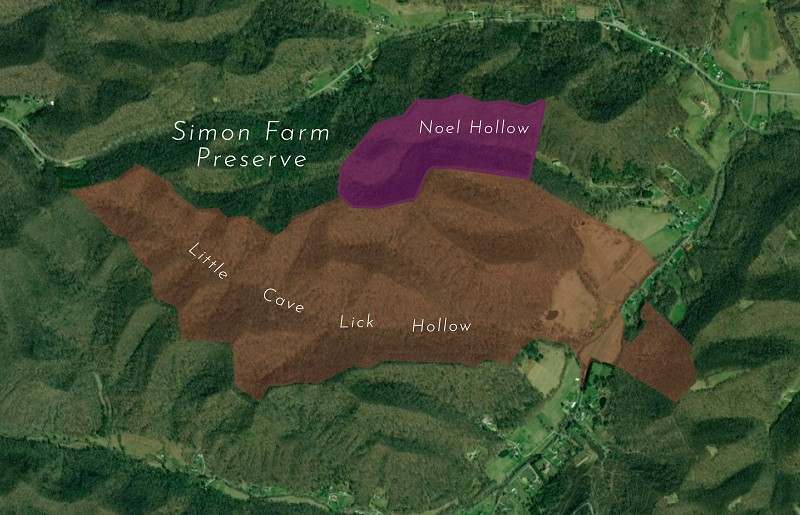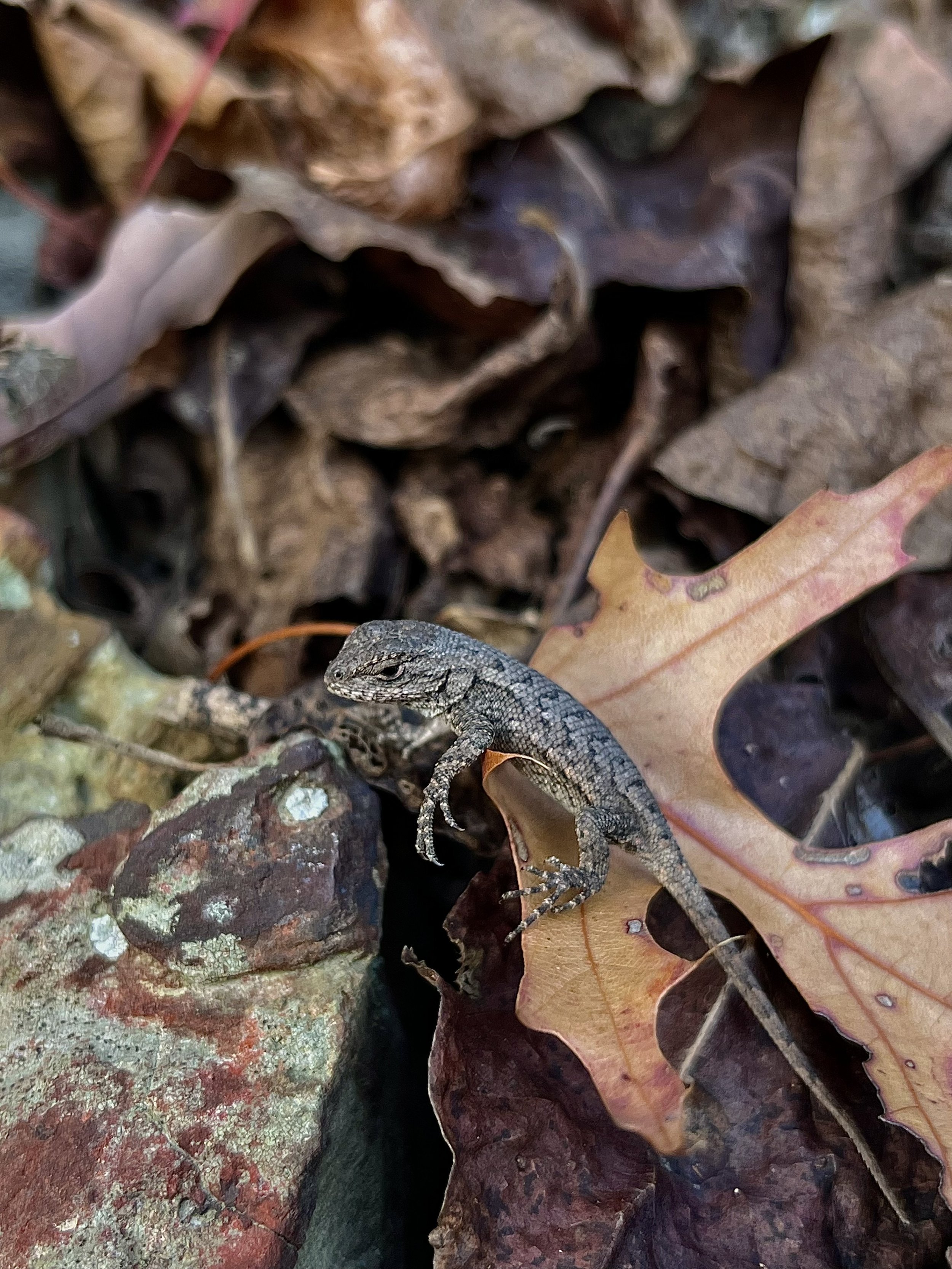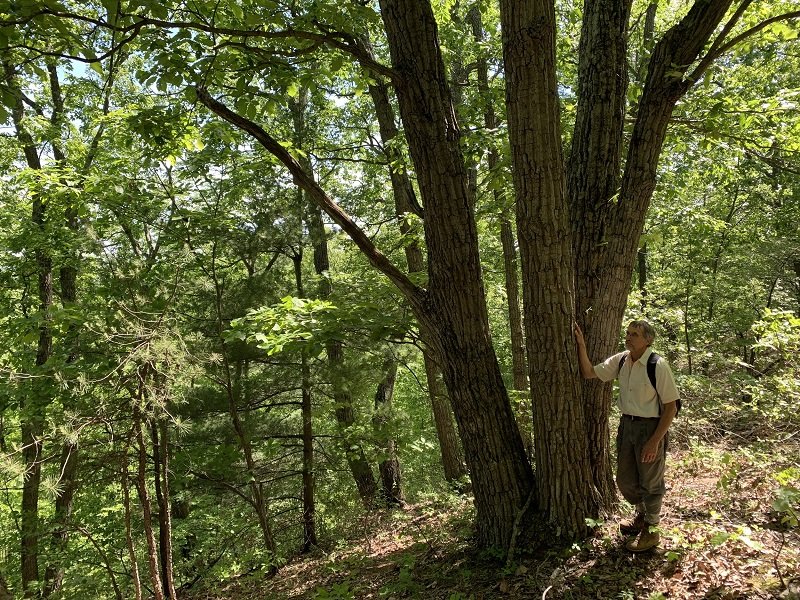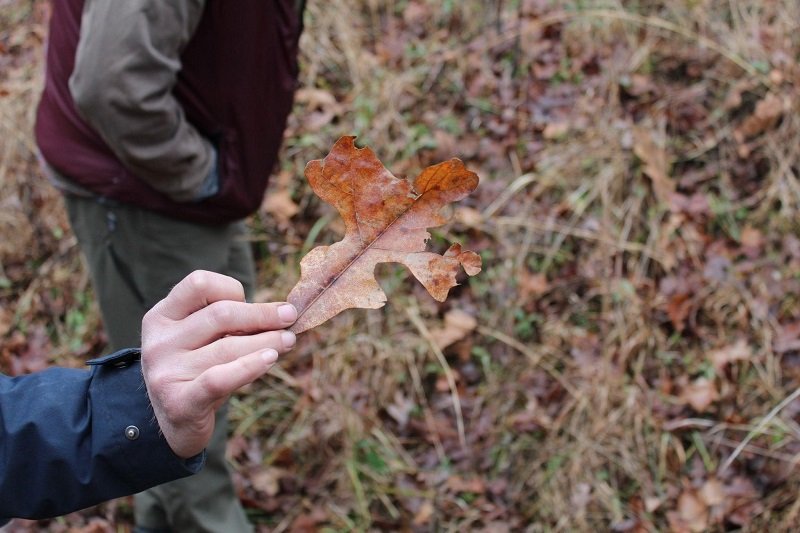Simon Woods Preserve during mountain laurel season. Photo by Elijah Crabtree.
Simon Woods
a new 670-acre preserve in Scioto County
Total Project Cost: $2,006,983 COMPLETED
Stewardship Endowment Goal: $1,200,000
Current Endowment Balance: $674,683
Balance to Raise: $525,317
An extraordinarily LARGE mature forest. Simon Woods is a large Scioto County preserve dominated by deeply forested, exceptionally steep Appalachian hills, and 60 acres of agricultural fields that once served as John R. Simon’s working farm. Here, the Arc of Appalachia still grows the farm’s distinctive crop of sorghum, fueling the preserve’s annual Simon Sorghum Festival. John Simon’s historic 19th-century 7-acre French farmstead is willed to the Arc, and will one day be rejoined with the rest of the farm. John founded a $500,000 endowment fund to help sustain the preserve and the annual festival.
One of the Arc’s most significant preserves. Simon Woods is among the Arc’s top three preserves in terms of size, richness in natural and cultural history, and scale of educational services. (The other two are Tremper Mound Preserve, just a few miles downstream, and the Arc’s headquarters, the Highlands Nature Sanctuary.)
Simon Sorghum Festival. The preserve hosts John’s annual Simon Sorghum Festival that he founded and kept running for 37 years. John ceased holding the event in 2018, due to its aging core organizers. The Arc resurrected the Festival three years later with the help of passionate neighbors and friends, and Arc volunteers. Today, this celebration of Appalachian music and heritage agrarian skills lives on!
Why Endowing Land Stewardship Is So Important for Wildlands Preservation
Each Arc Preserve requires enduring stewardship. To buy a preserve and not maintain it with the proper equipment, attention, and “boots on the ground” would be deeply irresponsible because an ignored preserve is a preserve only in name. No one’s land is everyone’s land.
The best and truly only insurance for successfully caring for Arc preserves is to build strong balances in our Stewardship Endowment Funds so that, over time, the fund’s annual income will substantially contribute to the yearly costs of sustainable stewardship. On the average, for every $1.00 invested in land acquisition, another $1.00 is needed in the endowment fund. For our larger preserves, the cost is much higher. We have a realistic chance of achieving sustainability if many of our Arc supporters choose to remember us in their wills and trusts. We also encourage donors to tick off the “restricted donation” option that will direct 50% of the gift to land acquisition and 50% to our primary “Stewardship Forever Endowment Fund.” Or, include a note with your check. See the following articles for deeper information:
Scroll down to learn more about the preserve.







Simon Woods - A new Arc Preserve
Less than a mile west, as the crow flies, from the sacred grounds of Tremper Mound lies the Arc of Appalachia’s new Simon Farm Preserve, named after John R. Simon, who previously owned this land and first envisioned the preserve. Here grows a forest so exemplary that its already-mature white oaks and chestnut oaks are well on their way to achieving old-growth status.
Simon Woods Natural History
The uplands of Simon Woods are heavily dominated by white oak and chestnut oak trees, making this one of the most beautiful forests in the Arc preserve system. Although the trees grow slowly on the steep, thin-soiled and rocky hillsides, they achieve majestic heights. Approximately 320 acres, roughly two-thirds of the preserve’s forest, is a fully mature woodlands with trees averaging 80-150 years in age, representing the Simon family’s multi-generational legacy. At the time the Arc acquired the property, the timber appraisal estimated over two million dollars’ worth of standing sawlogs. An additional and unusual forest type on the preserve is known as 0ak-pine barrens, an ecosystem that occupies the highest and most exposed elevations of the preserve, following long, narrow, ridgetops carpeted with broken, lichen-covered rocks. The mini-climatic condition is punishingly hot and dry. Even in the springtime, these areas can be scorchingly hot at times. Plants found in these fragile communities include chestnut oak, scarlet oak, black oak, blackjack oak, pitch pine, downy serviceberry, greenbrier, and Vaccinium (blueberries and huckleberries).
Simon’s large and contiguous forest ecosystem provides important breeding grounds for the many neotropical breeding bird species that need woodland habitats. Simon’s forest is even more critical for warblers that require large and unfragmented woodlands. These obligatory deep-woods warblers are declining in population due to habitat loss, and thus, the added preservation of any wooded tract the size of Simon Farm helps sustain their populations. Deep-woods warbler species that breed on the property include Kentucky warbler, worm-eating warbler, and hooded warbler.
Simon Woods Cultural History
The influx of settlers into Ohio in the early 19th century - families looking to utilize the forest bottoms for agriculture - was rapidly followed by profitable timber companies that were reinventing themselves with mechanical technologies and efficient railroad export. After Ohio became a state in 1803, the rich natural resources of the Ohio Territory were turned into market commodities more quickly than any other state in our fledgling nation’s history. Just 100 years after statehood, Ohio’s forest cover had dropped from 95% to 10%, with devastating consequences for the wildlife and waterways. When the Dust Bowl hit the West in 1930, conservation-minded individuals nationwide rallied Americans to steward their farmlands and forests more sustainably.
When John was born in 1936, America’s forest conservation movement was already well underway. John was three years old when Shawnee State Forest was founded (today our largest state forest) - its boundaries abutting right up to those of his father’s farm. John would have witnessed how much of the topsoil had already washed off the hills, and he would have watched the state forest’s young trees and thin soils beneath them begin to recover.
Given John’s sharp intelligence, he would have known that healthy intact forests were bonded to the fabric of Appalachian life and that forests needed to be protected as a historic Appalachian legacy. He believed in this principle so whole-heartedly that when 100 acres of forest came up for sale directly across the farm, he bought it for the simple reason that he did not want to see a hill stripped of its forest anywhere within sight of his home.
In 2022, after much deliberation with trusted family members and friends, John sold his beloved woods to the Arc. He then donated to the Arc (separately from the purchase), the historically-intact 6.4-acre 1864 rural homestead that had been occupied by four generations of his French ancestors. John Roger Simon made this gift of his homestead with retained life estate, and furthermore set up an endowment fund to help maintain it.
Expanding Simon Woods with Noel Hollow
As the Arc of Appalachia’s acquisition of Simon Farm took shape, John’s neighbor to the north, Brandon Hull, keenly observed the slow-paced process with interest and approval. Brandon, his wife Jeanna, and their young family live at the head of Noel Creek in the heart of Noel Hollow, adjoining Simon Woods on its northern border. Brandon and Jeanna generously offered to sell 95 acres of their forested hollow as an addition to the Simon Farm Preserve, and the offer’s culmination brought the preseve’s total size to 670 acres.

